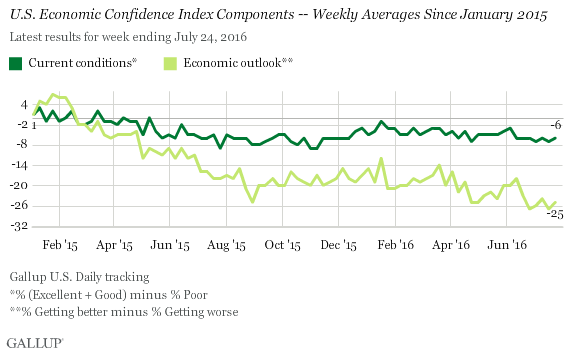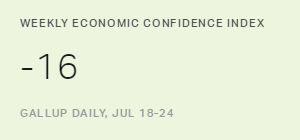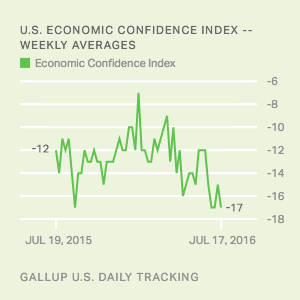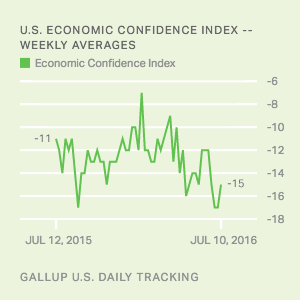Story Highlights
- Gallup U.S. Economic Confidence Index stands at -16
- Score remains near 2016 low of -17
WASHINGTON, D.C. -- Americans' confidence in the economy remains near its 2016 low, with Gallup's Economic Confidence Index at -16 for the week ending July 24. This represents essentially no change from the week before when the index was at -17, its lowest score in 2016.

In recent months, the Gallup Economic Confidence Index has languished near the low end of its 2015-2016 performance. The index reached a score of -7 in January when President Barack Obama gave his State of the Union address. In mid-April, the index reversed course falling to -16, as reports of weak retail sales were released and gas prices rose slightly. The index improved slightly in May, hitting -12 in the final week of that month before edging downward in mid-June. Economic confidence hit a low of -17 for the week ending June 26; it would hit this low point twice more in the following four weeks. This slumping confidence came even as the U.S. financial markets shook off the initial shock of the Brexit vote and the economy added far more jobs than expected in June.
Gallup's U.S. Economic Confidence Index is the average of two components: how Americans rate current economic conditions and whether they feel the economy is improving or getting worse. The index has a theoretical maximum of +100 if all Americans say the economy is doing well and improving, and a theoretical minimum of -100 if all Americans say the economy is doing poorly and getting worse.
The current conditions score was -6 last week, essentially where it has been since early June. This reflects 25% saying current economic conditions are "excellent" or "good" and 31% saying they are "poor."
With 35% of U.S. adults saying economic conditions in the country were "getting better" and 60% saying they were "getting worse," last week's economic outlook score came in at -25. This marked the sixth consecutive week this measure has registered a value of -23 or lower. Over the course of 2016, the economic outlook score has dropped more than the current conditions score.

Bottom Line
Americans' confidence in the U.S. economy remains subdued, with the index hovering near its 2015-2016 low. As in 2015, the index began 2016 on a high note before faltering in the spring and summer months. In both instances, Americans' outlook for the economy was largely responsible for the downward slide, as economic expectations are usually more responsive to short-term events than are current conditions.
The economy receives two important verdicts this week: The Federal Reserve will meet on Tuesday and Wednesday to assess the trajectory of the economy while the Commerce Department releases its second-quarter GDP estimate on Friday. But the resulting picture may be a muddled one -- the Federal Reserve is likely to refrain from raising interest rates (a sign of strong economic growth) even as it judges the economy to be in reasonable shape; the second-quarter GDP rate could show considerable improvement since the first quarter, but still remain at or around 2% growth, which is low by historical standards.
The Democratic National Convention takes place this week in Philadelphia, following the Republican National Convention last week. The latter produced little immediate change in Americans' views of the economy, though many speakers at the GOP convention derided the economy as weak. Democrats will present a different view of the economy in their convention; it remains to be seen which view, if any, Americans will find to be more persuasive.
Survey Methods
Results for this Gallup poll are based on telephone interviews conducted July 18-24, 2016, on the Gallup U.S. Daily survey, with a random sample of 3,027 adults, aged 18 and older, living in all 50 U.S. states and the District of Columbia. For results based on the total sample of national adults, the margin of sampling error is ±2 percentage points at the 95% confidence level. All reported margins of sampling error include computed design effects for weighting.
Each sample of national adults includes a minimum quota of 60% cellphone respondents and 40% landline respondents, with additional minimum quotas by time zone within region. Landline and cellular telephone numbers are selected using random-digit-dial methods.
Learn more about how the Gallup U.S. Daily works.



